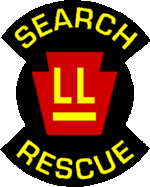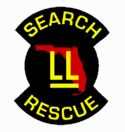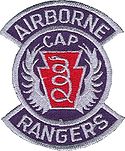- Civil Air Patrol Ranger
-
 The Pennsylvania Ranger shoulder patch was introduced in the 1980s[1]
The Pennsylvania Ranger shoulder patch was introduced in the 1980s[1]
A Civil Air Patrol Ranger is a volunteer of the Civil Air Patrol who has undergone training for emergency situations.
CAP Rangers have been involved in numerous local and national disasters. Rangers are involved in numerous areas of the emergency services field, such as disaster relief (Hurricane Katrina).
Contents
History
After World War II, as the United States shifted out of Wartime focus, Civil Air Patrol (CAP) sought a new purpose. Instead of patrolling sea lanes, CAP enlarged it's largely successful Search and Rescue operations. During the early 1950s, Colonel Phillip Neuweiler, commander of CAP's Pennsylvania Wing and an avid aviator, suffered a 'hard landing.' While laying on his back in a cornfield[2] afterwards, Neuweiler devised a plan to train CAP members for ground support of aerial search and rescue missions. He sent several teams to Westover AFB for instruction by United States Air Force Pararescuemen. The Air Force instructors were so inspired by the dedication, motivation, and quality of the students that they called their students 'Rangers.'[3][2]
The success of this one school inspired Col Neuweiler. In 1956 he moved the school to a property he owned in Berks County, and dedicated the land for use by CAP. During this time, the school was staffed by both Civil Air Patrol members and USAF personnel. During the late 1950s, the school continued to grow.
In the early 1960s, a cadet staff training program was implemented. For the first time, cadets would instruct other cadets, greatly enhancing the school's overall mission. The combined expertise of CAP personnel augmented and eventually replaced the need for USAF personnel to conduct training.[2]
During this time, CAP Rangers would not only conduct search and rescue missions by ground, but several teams also had Airborne members that would parachute into crash sites to quickly administer aid.[1]
 The shoulder patch worn by CAP Rangers from Florida
The shoulder patch worn by CAP Rangers from Florida
By the mid 1970s, several Ranger schools appeared around the country. Ranger Schools in the Everglades of Florida, at Black River Mississippi, and in Puerto Rico, all produced CAP Rangers. Washington Wing's Challenger School, a similar program, was also incorporated into the Ranger program. All of these schools were called National Emergency Assistance Training schools, or NEAT schools, by CAPNHQ in 1974. NEAT schools and served as the origins and basis for CAP's emergency services training.[3]
In 1972, female cadets were allowed to attend the Everglades Ranger School on an experimental basis. The experiment proved successful, and in 1973, female cadets were allowed to participate in all Ranger programs. In 1974, medical training was officially incorporated into the curriculum of all staff members, who would further expanding the capabilities of the Ranger program by teaching the material to Ranger trainees.
Although the Ranger program flourished and numerous Ranger schools were founded to teach the fundamentals of search and rescue, some perceived portions of the school as hazing or as an initiation process. Hazing allegations combined with a general decline of funding, led to the closing of nearly all Ranger Schools. Only the original Hawk Mountain Ranger School (HMRS) survived through the 1990s.
More recently, CAP Rangers have been involved in recovery efforts after Hurricane Katrina. 31 CAP Rangers from Pennsylvania Wing alone traveled 28 hours to Pascagoula, Mississippi to aid in relief efforts. Rangers from numerous other wings assisted as well.[4] CAP Rangers went door-to-door ensuring that local residents had the food, water, and medical care they needed.[5]The Ranger Creed
The Ranger Creed is adopted from the creed of the Air Force Pararescuemen that instructed the first Rangers. Ranger School cadets must memorize the creed, and graduates are said to live the creed.
The Ranger Creed is:[3]
My duty as a member of the Rangers of the Civil Air Patrol ground search and rescue service is to save lives, aid the injured, and protect their property. In order to do this, I will keep myself physically fit at all times. I will at all times perform my assigned duties quickly and efficiently, placing these duties before my own personal desires and comfort. These things I do that others may live...
Ranger advancement
Advancement through the various Ranger classes or grades requires a student to demonstrate knowledge of or proficiency in certain skills. There are often practical, fitness, and administrative sections.
- Ranger Third Class is the introductory level of Ranger Grades. For Ranger Third Class, a Ranger-to-be must demonstrate knowledge of basic outdoorsman tasks, complete a 2 mile hike, and perform a 1/2 mile run in 6 minutes or less. Cadets must have earned their first stripe (see Cadet grades and insignia of the Civil Air Patrol), and senior members must have completed Level 1 training. In addition, a ranger must sign a Declaration of Intent to join a Ranger Team (co-signed by a parent or guardian if under 18).[6]
- Ranger Second Class is the basic level of Ranger Grades. For Ranger Second Class, a Third Class Ranger must demonstrate knowledge of intermediate woodsman skills, possess introductory Search and Rescue skills, obtain a basic CAP radio operators license, and perform a 1/2 mile run in 5 minutes or less. Cadets must also have earned Cadet Senior Airmen, and seniors must have declared a specialty track.[7]
- Ranger First Class is the intermediate level of Ranger Grades. For Ranger First Class, a Second Class Ranger must possess certain qualifications from the Red Cross and the Federal Emergency Management Agency (FEMA), have completed a basic winter school, demonstrate advanced woodsman skills, possess intermediate search and rescue skills, be able to work on a team with search and rescue dogs, use an L-Per, and run 1/2 mile in 4 minutes or less. Cadets must also have earned Cadet Technical Sergeant, and seniors must have achieved a Technician rating in their specialty track.[8]
- Advanced Ranger is the advanced level of Ranger Grades. For Advanced Ranger, a First Class Ranger must possess certain qualifications from the Red Cross and FEMA, possess an advanced CAP radio operators certification, be qualified as a ground team leader, have completed advanced winter school, be comfortable leading a search and rescue team, understand how the national search and rescue system works, and complete a one mile run in 8 minutes or less. Cadets must earn Cadet Second Lieutenant, and senior members must attend Squadron Leadership School.[9]
- Instructor is the second highest level of Ranger Grades, and is reserved for those people who choose not to test for Expert Ranger. For Instructor, an Advanced Ranger must possess certain qualifications from the Red Cross and FEMA, attend Special Advanced Winter School, be knowledgeable in at least three different disciplines that benefit the ranger program (e.g. possess Emergency medical technician ratings, Military Service, Incident Commander ratings from FEMA, be a Registered Nurse, etc...), and be active in the Ranger Program for at least five years after being awarded Advanced Ranger. Cadets must earn Cadet Captain, and senior members must attain a Senior Rating in their specialty track.[10]
 Expert Rangers are authorized to wear the Expert Ranger tab over the Civil Air Patrol tape on their field uniforms.
Expert Rangers are authorized to wear the Expert Ranger tab over the Civil Air Patrol tape on their field uniforms.
- Expert Ranger Expert Ranger is the highest level of Ranger Grades, and is awarded only to those who embody the Ranger spirit. Becoming an Expert Ranger can only be accomplished by completing the 'Special Advanced Course Echo', which exposes Rangers to the Expert level of Search and Rescue, woodsman ship, and survival, and stresses the development of individual skills and self-confidence. Expert Rangers are awarded a Black Pistol Belt for wear with their uniforms. As of July 2011, only 240 people have become Expert Rangers since the program's inception in 1956.
Field Medic Program
Just as the Ranger Program was started, a need was apparent for medical training. However, for the first seven years of the Ranger program, all medical support was provided by Air Force personnel.
Beginning in 1960, Dr. William E.B. Hall of Allentown, Pennsylvania began providing for most of the health care needs of Pennsylvania Wing CAP, and consequently HMRS as well. As a CAP Lieutenant Colonel, Dr Hall commanded the PA Wing Hospital Squadron 3102, consisting of professional nurses, doctors, and other qualified medical personnel.
In the early 1970s, Lieutenant Don Kliptein recognized that many of the cadets coming to the school already had extensive medical backgrounds, but no ranger experience. In 1971, Lt Kliptein began training Cadets to assist Sq 3102 in providing medical assistance to other cadets. Cadet medics helping injured cadets quickly improved the overall atmosphere of the cadet program, leading to the introduction of the first dedicated medical course in 1973. This new course was structured to tie in directly with the Ranger program. Medic trainees would accompany Ranger trainees during the Field Training Exercise portion of Summer Schools, combining both Ranger experience with Medical training.[11]
Medic advancement
- Field Medics have completed the basic Field Medic course, and hold certification in Adult CPR and Wilderness First Aid.[11]
- Field Medic 1st Class is the typical medic assigned to a Ranger team. In addition to CPR and Wilderness First Aid, they have First Responder or Professional Rescuer qualifications. They have also completed the advanced field medic course.[11]
- Senior Medics are Operational medical specialists. Although qualified to assist ground teams, Senior Medics typically support base operations or even multi-agency mission bases. Senior Medics must be at least 18 years of age, hold EMT-B qualifications or higher, and be well versed in several areas of advanced medical care. Senior Medics are awarded Red Scarves to wear with their uniform.[11]
- Master Medic represent the leadership of the Medic Program, and are similar to Expert Rangers. They typically hold instructor ratings in multiple medical fields. In addition to the Red Scarf, Master Medics are awarded a Red Pistol belt. Only 21 people have become Master Medics since 1972.[11]
Ranger Staff
The 2008 HMRS Ranger Staff Handbook defines Ranger Staff as being:[2]
(...) highly trained, extremely motivated, and well disciplined member of the Ranger Program, who lives by a strict code of ethics and an honor code. [He or she] would rather resign that bring disgrace upon the Ranger Program. They are dedicated and committed to achieving the goals of Civil Air Patrol and the Ranger Program. They are dedicated not to any one person but rather the Program as a whole. [He or she] is dedicated to the art of teaching and the principles of training. A Staff [Member]'s leadership training lends itself to accomplishing the mission faster and more effectively. Ranger and Medical training is a key ingredient to aiding the injured and saving lives. [He or she] will never fail at anything they do. If something does not turn out as expected, it is used as a learning experience and will eventually enhance their ongoing training. [He or she] welcomes the challenge of doing the unexpected or untried. Staff members are trained to forge ahead and create a path rather than follow others or to sit by idly. [He or she] is trained to identify, adapt, an overcome difficult situations or obstacles.The Ranger Staff Motto is "We Lead."[2]
History of the Ranger Staff
As the Ranger Program expanded and gained national recognition in the late 1950s, leaders of the program saw an increasing need for more staff members to oversee the program. Especially few were cadet leaders capable of instructing other cadets.
In 1960, Lieutenant Colonel John Weaver developed a program to train cadets as Ranger Staff at Hawk Mountain Ranger School (HMRS). At the time, Lt Col Weaver was commander of Pennsylvania Wing's Ranger program, and appointed Major John McNabb to oversee the new cadet staff program.
As the Ranger program matured, it also expanded well beyond the boundaries of Pennsylvania. As students from other states attended HMRS, they took home the knowledge and pride they earned. Inspired by several cadets, Major Fred Graham of the Florida Wing began a Ranger Staff Training Program in the Everglades. Staff Cadets from Florida served alongside Pennsylvania Wing Staff members at HMRS, as well as at the Ranger School in Black River, Mississippi.
Staff training
Ranger Staff training typically occurs over eight weekends from early Spring through early summer. Each weekend focuses on a different area of staff expertise, such as 'survival weekend' or 'ropes weekend.'
Staff training is typically broken into two groups. New staff trainees train together to familiarize themselves with what is expected of a Ranger Staff Member, while returning staff members typically focus on enchaning their leadership abilities and knowledge of the various Ranger disciplines.
In the Summer of 2005, Hawk Mountain Ranger School began offering a summer course to train cadets to be Ranger Staff. This course compresses the entire 8 weekend traditional course into approximately 9 days, conducted simultaneously with the school's other summer courses. This course is offered to further promote the CAP Ranger program beyond Pennsylvania.[12]
Staff distinctions
Staff personnel at Ranger schools wear distinctive uniforms. While Ranger trainees wear BDUs with brown T-shirts underneath, Ranger Staff wear orange t-shirts under their BDU's. Master Medics may wear red T-shirts and Expert Rangers may wear black T-shirts. Staff members also wear pistol belts and they wear military bib scarves whenever on base and the overblouse is also worn.
Military Bib Scarves
Scarves comply with US military specifications. They are worn around the neck and are tucked into the BDU blouse. When blouses are removed due to high temperatures, scarves are also removed.
- Grey Scarves denote Ranger Staff trainees, and are only worn during Ranger Staff Training.
- Yellow Scarves denote Ranger Staff that have completed one year of Staff Training.
- Orange Scarves denote Ranger Staff Members that have completed a second year of Staff Training.
- Green Scarves denote Basic Field Medics, personnel that have completed the initial training course.
- Red Scarves denote Medic First Class, Senior Medics, and Master Medics.[11]
Pistol belts
Staff Members wear a pistol belt at all times. Despite their name, no pistol is worn on the belt, nor is other equipment.
- White Belt denotes a staff member
- Black Belt denotes an Expert Ranger.
- Red Belt denotes a Master Medic.
Ranger Schools
Several Schools have been created solely for the purpose of training CAP Rangers. Those that still operate today are:
- Hawk Mountain Ranger School, the original Ranger School created by Col Phillip Neuweiler in Pennsylvania
- Florida Wing Glades Ranger School A School originally operated in the 1970s and 80s, reopened in 2004[2]
- Snake River Ranger Training Area, where the Florida Ranger Program was resurrected in 2004. Also known as the Florida Falcon Ranger Academy[13]
Schools that have closed are:
- Black River Mississippi Ranger School, operated in 1975 and 76
- Everglades of Florida Ranger School, first operated in 1970 by Major Fred Graham to train Ranger Staff
- Puerto Rico Ranger School, developed by Colonel Bartolo Ortiz
References
- ^ a b "History Of The Ranger Program". March 2006. http://www.pawingcap.com/docs/Wingslip_2006_03.pdf. Retrieved 2008-10-01.
- ^ a b c d e f "Hawk Mountain Ranger School History" (PDF). 2008. http://www.pawingcap.com/hawk/forms/2008_RStaff_Handbook.pdf. Retrieved 2008-10-01.
- ^ a b c "History Of The Ranger Program". http://www.pawingcap.com/hawk/history.htm. Retrieved 2008-09-29.
- ^ "Hurricane Relief". http://mhuchette.albumpost.com/Hurricane-Relief?page=1. Retrieved 2008-10-23.
- ^ 1st Lt Elizabeth Hornbach (September 2005). "Pennsylvania Wing Aids in Disaster Relief" (PDF). http://www.pawingcap.com/docs/Wingslip_2005_09.pdf. Retrieved 2008-09-30.
- ^ "Ranger Third Class Certification" (PDF). http://www.pawingcap.com/hawk/forms/RangerThirdClassTestingSheetMar2007.pdf. Retrieved 2008-09-29.
- ^ "Ranger Second Class Certification" (PDF). http://www.pawingcap.com/hawk/forms/RangerSecondClassTestingSheetMar2007.pdf. Retrieved 2008-09-29.
- ^ "Ranger First Class Certification" (PDF). http://www.pawingcap.com/hawk/forms/RangerFirstClassTestingSheetMar2007.pdf. Retrieved 2008-09-29.
- ^ "Advanced Ranger Certification" (PDF). http://www.pawingcap.com/hawk/forms/AdvancedRangerTestingSheetMar2007.pdf. Retrieved 2008-09-29.
- ^ "Instructor Certification" (PDF). http://www.pawingcap.com/hawk/forms/InstructorTestingSheetMar2007.pdf. Retrieved 2008-09-29.
- ^ a b c d e f "Medic History". http://www.pawingcap.com/hawk/medic_history.htm. Retrieved 2008-10-01.
- ^ "Summer Ranger School Cadet Staff Training Course (Romeo Squadron)". http://www.pawingcap.com/hawk/cadet_staff_training.htm. Retrieved 2008-10-22.
- ^ Maj Herbert Cahalen (January 2005). "Hawk Mt Ranger Staff Helps Kick Off the First Florida Falcon Ranger Academy" (PDF). http://www.pawingcap.com/docs/Wingslip_2005_01.pdf. Retrieved 2008-09-30.
See also
Categories:- Civil Air Patrol Cadet Programs
Wikimedia Foundation. 2010.

